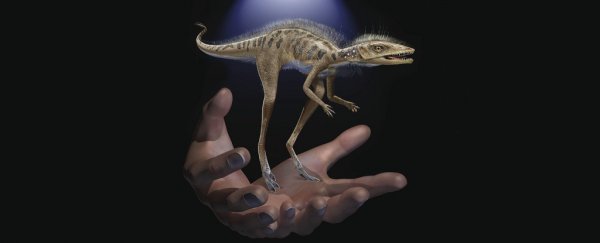Its name was Kongonaphon kely, which means 'tiny bug slayer', and it was about the size of a coffee cup. But big things lay ahead for this little creature. Very big things indeed.
The tiny bug slayer, which lived on Madagascar approximately 237 million years ago during the Triassic period, stood just 10 centimetres (about 4 inches) tall. Nonetheless, scientists say K. kely belonged to the ancient group Ornithodira: the last common ancestor of all the dinosaurs and pterosaurs that would one day reign in the bug slayer's wake.
"There's a general perception of dinosaurs as being giants," says palaeontologist Christian Kammerer from the North Carolina Museum of Natural Sciences.
"But this new animal is very close to the divergence of dinosaurs and pterosaurs, and it's shockingly small."
 Artist's impression. (Alex Boersma)
Artist's impression. (Alex Boersma)
How did such colossal creatures evolve from such unassuming origins? The answer has never been entirely clear, since relatively few specimens from the root lineage of Ornithodira have ever been discovered and studied.
That's why the bug slayer's old bones are so important. They were first found during field work in 1998 at a fossil site in southwestern Madagascar, along with the remains of hundreds of other ancient specimens.
"It took some time before we could focus on these bones, but once we did, it was clear we had something unique and worth a closer look," says palaeontologist John Flynn from the American Museum of Natural History.
K. kely is the smallest known species in a family of early dinosauromorphs called Lagerpetidae. These early examples of Ornithodira are known to be small, but with recent discoveries such as the tiny bug slayer, researchers are coming round to the idea that the smallness of discovered specimens is no accident.
"Although dinosaurs and gigantism are practically synonymous, an analysis of body size evolution in dinosaurs and other archosaurs in the context of this taxon and related forms demonstrates that the earliest-diverging members of the group may have been smaller than previously thought, and that a profound miniaturisation event occurred near the base of the avian stem lineage," the team writes in a new paper.
 (Phylopic.org by Scott Hartman [CC BY 3.0] & Frank Ippolito/AMNH)
(Phylopic.org by Scott Hartman [CC BY 3.0] & Frank Ippolito/AMNH)
Above: Body size comparison between Kongonaphon kely, and early dinosaur Herrerasaurus.
Evidence to support this comes in the form of the tiny bug slayer's teeth and pitted abrasions on them, consistent with a diet of hard-shelled insects, the team says. If they're right, it's possible that these smaller dinosaur and pterosaur ancestors adapted their diminutive frames to "invade resource zones not previously occupied by archosaurs" as a kind of evolutionary advantage.
In doing so, it's also possible that the shift to this tiny body helped K. kely and its archosaur peers unlock and develop other traits that would go on to become a mainstay of their descendants' survival: innovations in bipedal movement, the origins of fluff to warm small bodies, and even the beginnings of flight, the researchers suggest.
The tiny bug slayer didn't get to see or enjoy all that for itself, of course. But those ambitious tomorrows had some of their beginnings here.
The findings are reported in PNAS.
